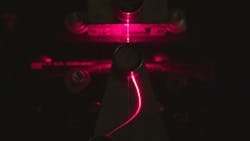Researchers at VTT Technical Research Centre of Finland (Espoo, Finland) have created a wood-based optical fiber that transmits light in the 500 to 1400 nm spectral range, with an attenuation of 6.3 dB/cm at 1300 nm. Optical fiber made of cellulose is best suited for sensors that benefit from the biodegradability of the material, say the researchers. Cellulose has properties that make it ideal for use in certain optical-fiber sensors: The material used in cellulose fibers can in itself react with the substances being measured and absorb them, which is difficult for glass or plastic fibers. Cellulose is also easy to modify in regards to, for instance, the index of refraction. Cellulose effectively absorbs and releases water, which can be measured by the change in the attenuation of light transmitted in the fiber. In addition, cellulose is biodegradable, and the fiber used for the sensor can be disposed of with biowaste.
The core of the dry-jet wet-spun fiber, which is about 210 µm in diameter, is cellulose-modified for the purpose using ionic solvents developed by VTT; around the core is a 3.4-µm-thick cladding made of cellulose acetate. A significant form of loss in the core at its wavelengths of higher transmission is scattering, which the researchers say can be reduced with better cellulose fiber alignment in the core. The cellulose fibers were cut with a razor blade, as a fiber cleaver cannot be used on cellulose. This form of cutting left an uneven edge that raised coupling losses; the researchers say that they are looking for a better way to cut these fibers.
The researchers tested a length of the cellulose fiber as a water sensor. Submerging a 76 mm section of the fiber resulted in an additional attenuation of 30 dB after about 10 minutes, triggered by swelling of the fiber. Bringing the fiber out of the water and letting it dry for 20 minutes returned the excess attenuation to zero. Cellulose-based fiber opens up new opportunities for sensors, but it clearly will never compete with glass-based optical fibers in telecommunications applications. In the future, optical cellulose fiber may allow detecting changes in the moisture level of buildings, say the researchers. Reference: H. Orelma et al., Cellulose (2019); https://link.springer.com/article/10.1007/s10570-019-02882-3.

